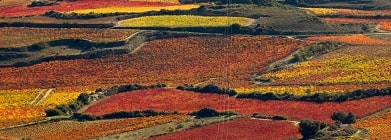It is comprised of the same members and voting percentages as the Board Directors of the Rioja Wine Interprofessional Organization, and it is appointed by the Ministry of Agriculture, Food and the Environment (MAGRAMA). Its functions are referred to in the Regulations (Art. 39). It is responsible for setting out the policy of the wine region, which is based on two pillars: promotion and focusing on markets; and development and production and quality controls. It establishes guidelines, approves rules and regulations and develops general policies from the proposals submitted by the committees. Also present in the Plenary meetings —although without voting rights— are the General Secretary-Director and a representative of each of the Autonomous Communities and a representative of the Ministry. When matters affecting particular departments have to be discussed, the heads of these departments may be required attend.
STRUCTURE AND ORGANISATIONAL CHART

Management Body
It consists of the Control Board Plenary, Standing Committee and working committees, President’s Office, as well as the General Secretariat-Directorate and the Marketing and Communication, Administration and Legal departments, except the Empowered Overseers Service, which is a completely independent department carrying out inspection and control tasks.
Control Board Plenary
President
The President of the Rioja Wine Interprofessional Organization. Highest representative of the Control Board (Art. 40). Institutional and legal representation functions before any third party and any other representation delegated by the Plenary. The President calls meetings, establishes the agenda based on working committee requests, and chairs the meetings of the Plenary and of the Standing Committee, determining when discussions and voting should take place. The President ensures compliance with decisions made and endorses the minutes of the meetings, as well as certifications relating to the decisions reached. The President seeks to coordinate associations and strengthen their mutual ties. The president is awarded the necessary powers to enter into contracts as set out in the contracting procedures-manual and established spending levels. The Ministry may also delegate powers to institute proceedings.
Standing Committee
Its functions are also set out in Regulations (Art. 39). It has no executive power, except when delegated by the Plenary, and it is composed of the Control Board President, the chairs of each of the committees and a maximum number of members based on the representation of each association. The General Secretary-Director and the heads of the departments affected by items on the agenda also attend the commission.
Working Committees and Committee Chairs
They are non-executive committees which initially examine matters and proposals to be dealt with by the Plenary. Their chairs are elected from among the members of the Plenary. They call and moderate discussions in their respective commissions. They work in coordination with the General Secretary-Director and with the department heads who are also the secretaries of their respective committees. Committee chairs jointly decide with the General Secretary-Director and the Control Board President whether matters should be referred to the Standing Committee and, as the case may be, to the Plenary. They may represent the Control Board in matters regarding the area of responsibility of their committee.
General Secretary-Director
The Control Board’s chief executive, carrying out the normal tasks that would be carried out by the general director or general manager in a company. Ultimately, it is a question of making effective the delegation of management functions, as set out in Art. 39, taking on the responsibilities of the Board’s day-to-day business. The General Secretary-Director is subject to the Plenary and reports to the President. In general, the General Secretary-Director’s responsibilities include: supervising promotion campaigns; organising the staff in all its aspects; preparing submitting and monitoring budgets and financial statements; coordinating departments and, in particular, ensuring that the Legal Department and Administration Department provide the necessary means to the Control Body according to the budgets established for the Board every year. Annual targets are set by the Plenary and the General Secretary-Director makes a proposal to the Plenary on the annual objectives to be met by department heads.
Marketing and Administration Department
The department is in charge of programming, developing and deploying promotional campaigns approved by the Board Plenary in accordance with assigned budgets. When necessary, it provides market studies requested by the Control Board’s various areas; for example, in order to make decisions regarding product requirements. Likewise, the department is in charge of the communication of all Board areas, including matters related to controls within an annual plan, which is continuously adapted to Board interests.
Administration Department
The department provides the Board (Plenary, General Directorate, and other departments) with the information and resources it requires to carry out its tasks. It is responsible for the full financial and administrative organisation of the Control Board. The department collects information from the Control Body and manages and updates vineyard and winery records. It also stores and issues guarantee labels and seals. It also provides IT support and supports the wine approval process.
Legal Department
It is a horizontal department in charge of the legal advisory service and of filing non-disciplinary proceedings. It also provides legal advice for the Control Body. It can also file disciplinary proceedings, provided the Ministry delegates such function.
Operation of the departments
The heads of the Administration, Marketing and Communication and Legal departments report to the General Secretary-Director, who is their hierarchical and functional supervisor. Obligations include the fulfilment of annual goals approved by the Plenary or the Standing Committee to ensure the proper operation of each Department and their staff, as well as coordination with other departments.
Control Body
The Board Controlling Body controls the Wine Region both administratively and on the field, with activities as diverse as managing the Register of Wineries and Register of Vineyards, managing the Grape Grower’s Cards and monitoring growing practices, grape production and wine production, inspecting wineries and vineyards, monitoring the movement, ageing and marketing of wines, checking and monitoring guarantee documents, obtaining market samples and, finally, producing statistics.














